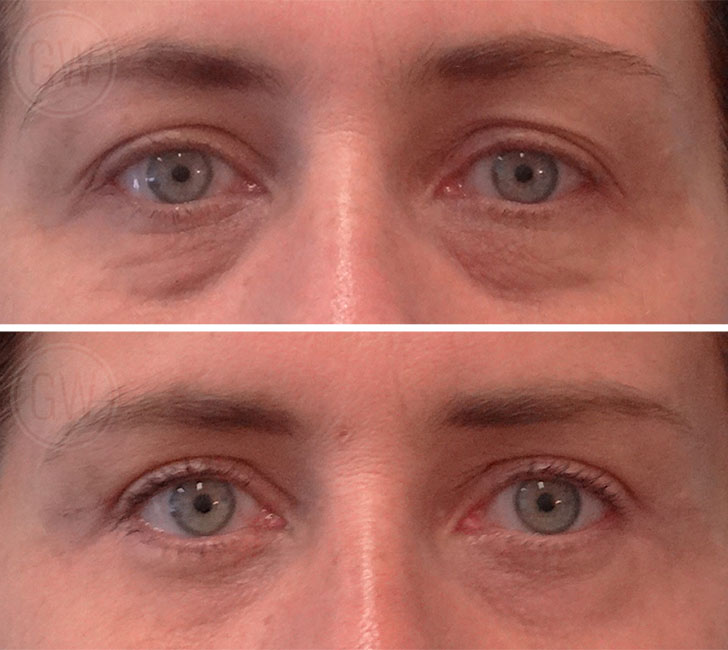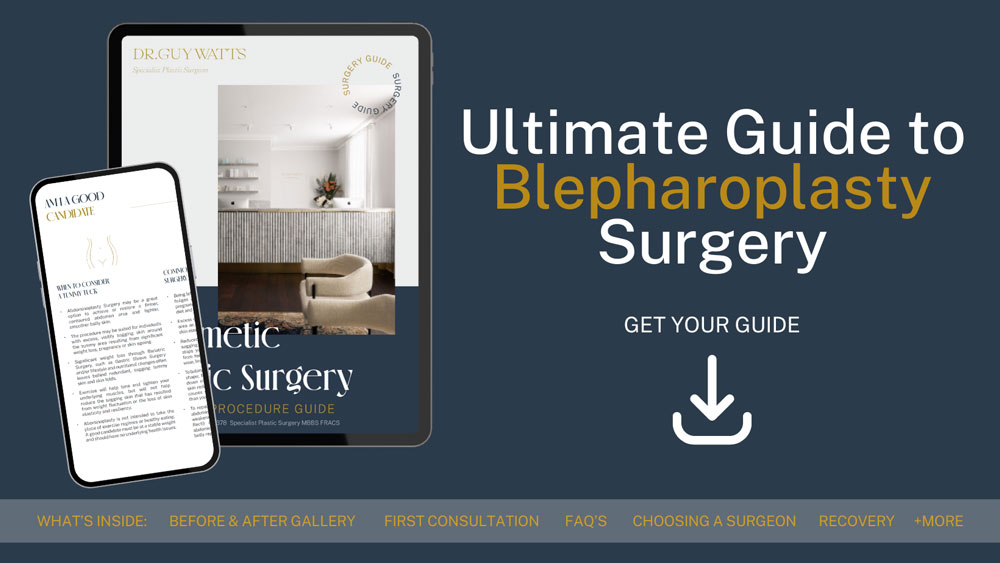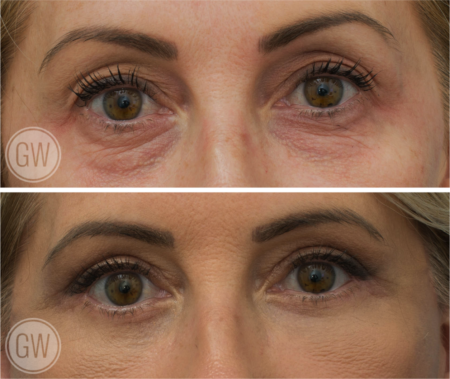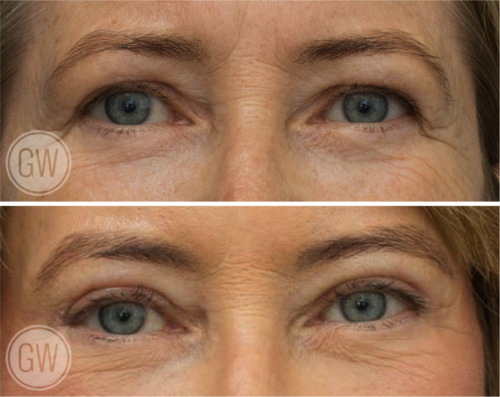
04 Oct Recovery After Lower Blepharoplasty
Lower blepharoplasty is a surgical procedure that addresses changes in the lower eyelid region, including puffiness, shadowing or contour irregularities that may develop due to ageing, genetics or environmental factors. The procedure typically involves repositioning or removing fat, and in some cases adjusting skin or muscle, to modify the transition between the lower eyelid and upper cheek. While results vary between individuals, the aim is to achieve a smoother, refreshed appearance while respecting the natural anatomy of the eye.
Because the lower eyelid is both delicate and functionally important, this surgery requires a thoughtful, individualised approach. Dr Guy Watts is a Specialist Plastic & Reconstructive Surgeon based in Perth, Western Australia, offering lower blepharoplasty to patients seeking evidence-based care. He holds the FRACS (Plast) qualification and provides a comprehensive consultation process, meaning patients receive a clear understanding of the procedure, potential risks and expected outcomes.
Recovery is a key part of the surgical journey. It begins immediately after the procedure and continues for several weeks or months as the body heals. For patients considering lower blepharoplasty with Dr Watts in Perth, understanding what to expect during recovery can support informed decision-making, appropriate planning and a more comfortable experience overall. This guide outlines the recovery timeline, common post-operative milestones, and considerations relevant to Perth’s climate and lifestyle.
Take our quiz, and find out if you are ready for surgery
Understanding Lower Blepharoplasty And Its Purpose
Lower blepharoplasty involves precise surgical modification of the tissues beneath the eyes to address changes that may contribute to a tired or heavy appearance. The procedure is performed under general anaesthesia or sedation and typically takes one to two hours, depending on its complexity. It may involve the careful repositioning or removal of fat deposits, conservative skin excision, and in some cases, tightening or support of the underlying muscle (orbicularis oculi). The aim is to create a seamless transition between the lower eyelid and the upper cheek while preserving the natural shape and function of the eye.
This procedure may be suitable for individuals who have developed persistent puffiness, visible under-eye bags, or a hollowed or shadowed appearance in the lower eyelid region. These changes may occur gradually with age or be more prominent at a younger age due to inherited anatomy. Lower blepharoplasty is not intended to change the character of a person’s face, but rather to address specific structural concerns that have not responded to skincare or non-surgical options. A full consultation is essential to determine whether the procedure is appropriate, particularly for those with dry eyes, previous eye surgery, or underlying health conditions that may affect healing.
There are several surgical approaches, including the transconjunctival technique, where incisions are made inside the lower eyelid to access and reposition fat without removing skin, and the subciliary technique, where a fine incision is placed just beneath the lash line to allow for both skin and fat adjustment. The choice of technique depends on the amount of skin laxity, the presence of muscle laxity, and the quality of the support structures around the eye. At his clinic in Perth, Dr Guy Watts uses an individualised approach, selecting the most appropriate method based on clinical examination, photographic analysis and patient goals. His focus is on achieving balanced results that align with the patient’s natural anatomy while minimising disruption to the delicate lower eyelid structures.
What To Expect During Recovery
Recovery following lower blepharoplasty is a gradual process that varies between individuals. In the first few days after surgery, swelling and bruising are common and usually most noticeable around the second or third day. Resting with the head elevated and using cold compresses, as advised, can help manage these early changes. Discomfort is generally mild, but any increasing pain or sudden changes in vision should be reported promptly.
Sutures, if placed on the skin surface, are typically removed within five to seven days. By the end of the first week, many patients notice a reduction in bruising and swelling, although some residual puffiness can persist. Light activities are often resumed at this stage, but strenuous exercise, heavy lifting and bending should be avoided until cleared by Dr Watts.
Over the following weeks, swelling gradually subsides and the lower eyelid area begins to settle into a more stable appearance. Makeup to cover bruising or redness may be used once the skin has sufficiently healed and only after approval from Dr Watts. Many patients feel comfortable returning to work and social activities within one to two weeks, though individual healing times can vary. Final refinement of the surgical result often takes several months as scar tissue softens and natural eyelid movement resumes.
At his practice in Perth, Dr Guy Watts provides tailored post-operative guidance at each stage of recovery, fostering patient understanding of what is expected and when to seek review. This ongoing care is an important part of supporting both comfort and long-term outcomes.
The First 24 To 72 Hours: Immediate Post-Operative Care
The early days following surgery are generally focused on rest and gentle care. Swelling and bruising often begin soon after the procedure and typically peak within the first two to three days. This is a normal inflammatory response as your body begins the healing process.
Dr Watts advises patients to elevate their head when resting and to apply cold compresses intermittently during this period. These measures can help reduce swelling and support comfort. Mild tightness or discomfort around the eyes may occur, but severe pain is uncommon and should be promptly discussed with the surgical team.
It is important to keep the area clean and to avoid touching or rubbing the eyes. In many cases, fine sutures are used to close incisions, and these are typically removed around five to seven days after surgery, depending on the technique used.
The First Week: Supporting The Healing Phase
As the days progress, the bruising often shifts in colour from deep purple to yellow-green as the body naturally clears the blood pigments under the skin. Swelling typically begins to decrease by the fifth to seventh day.
During this phase, patients in Perth are encouraged to stay indoors where possible, especially avoiding direct sun exposure, which can affect scar healing. Sunglasses may help protect the area when going outdoors, though this should be done sparingly until advised otherwise by Dr Watts.
Light activities around the home are generally permitted, but bending over, lifting heavy objects or engaging in strenuous tasks should be avoided. Some patients feel comfortable returning to desk-based work by the end of the first week, but this can vary. If work involves social interaction or screen time, allowing additional time may be more practical.
DOWNLOAD DR WATTS’ GUIDE TO BLEPHAROPLASTY

The Second Week: Gradual Resumption Of Everyday Activities
By the second week, most of the initial swelling and bruising will have subsided for many patients. At this point, sutures have usually been removed and incisions are beginning to heal. Some mild residual puffiness or tightness may persist, especially in the mornings, but this generally improves each day.
Makeup to cover residual bruising may be permitted from the 10-day mark, but only once cleared by Dr Watts or a member of his clinical team. It is important not to apply products too early, as this may irritate the healing skin.
Patients may begin walking outdoors gently, taking care to wear protective eyewear and a broad-brimmed hat when exposed to Perth’s sunlight. Any exercise that increases blood pressure or causes facial strain should still be avoided at this stage.
Weeks Three To Six: A Clearer Sense Of Progress
By three weeks post-surgery, patients usually notice a significant improvement in swelling and eyelid contour. The incisions, while still maturing, are often less visible and less sensitive. At this stage, many individuals feel comfortable returning to social events and work activities without camouflage.
Low-impact physical activity can usually be reintroduced around the four-week point, based on individual progress and the nature of the procedure. Dr Guy Watts reviews each patient personally and provides tailored recommendations to ensure safe recovery.
Most of the visible signs of surgery tend to diminish significantly during this phase, although subtle changes may continue for several more weeks.
Long-Term Recovery: Months One To Three And Beyond
Healing continues well beyond the initial month. While most swelling resolves by six weeks, the final outcome of lower blepharoplasty may take three to six months to fully evolve. This includes softening of scar tissue, continued reduction in residual swelling, and normalisation of sensation around the eyelids.
Scar maturation can take up to 12 months. Dr Watts uses fine suturing techniques and recommends post-operative skin care to support discreet healing, particularly in a sun-rich climate like Perth’s. Sunscreen, gentle skin products, and avoiding excess squinting or rubbing of the eyes contribute to a more stable outcome over time.
When To Seek Additional Advice
While complications after lower blepharoplasty are uncommon, being aware of warning signs is an important part of recovery. Patients should promptly contact their surgeon if they experience symptoms such as persistent or worsening pain, redness that spreads, sudden swelling, changes in vision or any discharge from the incision site. These issues may indicate infection, bleeding or other concerns that require timely medical assessment. Early intervention can often prevent more significant problems and support a smoother recovery.
At his Perth practice, Dr Guy Watts provides every patient with detailed post-operative instructions tailored to their procedure and health profile. These include clear guidance on wound care, activity restrictions and when to seek urgent advice. Follow-up appointments are scheduled to closely monitor progress, assess healing of the delicate eyelid tissues and ensure any concerns are addressed without delay. This structured approach to aftercare is designed to help patients feel supported throughout the recovery journey and to promote the best possible long-term outcomes.
Do’s And Don’ts During Lower Blepharoplasty Recovery
After lower blepharoplasty, following post-operative instructions plays a vital role in supporting comfort and healing. Patients are encouraged to keep their head elevated when resting or sleeping, particularly during the first week, as this helps reduce swelling. Cold compresses can be applied intermittently during the first 48 hours, as directed, to further ease puffiness. It is also important to attend all scheduled follow-up appointments, as these allow Dr Guy Watts to carefully monitor healing and adjust advice as needed. Only prescribed eye drops or ointments should be used, as these are chosen to protect the delicate tissues of the eyelids. When going outdoors, sunglasses and a high-SPF sunscreen should be worn to shield the area from Perth’s strong sunlight, which can otherwise affect scar healing.
At the same time, there are habits and activities that should be avoided while the eyelids are healing. Rubbing or pressing on the eyes can interfere with delicate stitches and prolong swelling. Smoking should be avoided as it reduces blood flow and impairs wound repair. Makeup should not be applied until Dr Watts confirms it is safe to do so, as premature use can irritate the healing skin and increase the risk of infection. Strenuous exercise, bending or heavy lifting should be delayed for at least three to four weeks, as these can raise blood pressure and disrupt the healing process. Patients should not use over-the-counter creams or medications on the eyelid area without approval, since some products can irritate sensitive tissues during recovery.
Lower Blepharoplasty Surgery Before and After Photos
Photo disclaimer:
Each surgical procedure produces unique outcomes influenced by factors such as body composition, skin tone, laxity, age, and genetics. The before-and-after photographs displayed are of actual patients and are provided for informational purposes only.
Local Considerations: Recovery In Perth’s Climate
Perth’s environment presents some unique recovery considerations. With high levels of sunshine and a dry summer climate, protecting your healing skin from UV exposure is essential. Dr Watts recommends consistent use of sunscreen and appropriate sun protection for all patients, especially during recovery periods when the skin is more sensitive.
Access to cooling, air-conditioned spaces during hotter months may also support comfort during early recovery. Patients are encouraged to rest indoors and plan follow-ups accordingly during Perth’s warm season.
Why Patients In Perth Choose Dr Guy Watts
When considering surgery around the eyes, selecting a fully qualified surgeon is an important step. Lower blepharoplasty requires a detailed understanding of both the function and appearance of the eyelids, as even small adjustments can influence comfort and balance. In Australia, only surgeons who hold the qualification of FRACS (Plast) are recognised as Specialist Plastic Surgeons by the Royal Australasian College of Surgeons.
Dr Guy Watts is a Specialist Plastic & Reconstructive Surgeon based in Perth, Western Australia, with training completed both locally and internationally. His approach to lower blepharoplasty focuses on careful surgical planning, evidence-based techniques and close follow-up after the procedure. Patients receive clear guidance at every stage, from preparing for surgery to navigating the recovery process, with advice tailored to their needs.
By consulting with Dr Watts in Perth, patients can feel supported by a surgeon who combines specialist qualifications with a commitment to thorough care. Every aspect of treatment, from consultation through to recovery, is approached with precision and an emphasis on patient safety.
FAQs About Recovery After Lower Blepharoplasty
Ready To Learn More?
If you are considering lower blepharoplasty and would like more information on what recovery might look like in your individual case, Dr Guy Watts, Specialist Plastic & Reconstructive Surgeon, invites you to schedule a consultation at his Perth clinic. Understanding the recovery process is an important part of making an informed decision. Dr Watts and his team provide support before, during and after surgery to help patients feel well-prepared every step of the way.
Arrange a consultation and learn more about whether lower blepharoplasty is suitable for you.
Further Reading
- Read more about Dr Guy Watts’ Procedure Eyelid Surgery – Blepharoplasty
- Read more about Dr Guy Watt’s Blog on Does It Hurt to Get the Blepharoplasty Stitches Removed?
- Read more about Dr Guy Watt’s Blog on Can Blepharoplasty Affect Your Vision?
- Read more about Dr Guy Watt’s Blog on Sunken Eyes – Causes and Options
About Dr. Guy Watts – MED0001539378
FRACS (Plas) – Specialist Plastic Surgeon In Perth WA
Dr. Guy Watts is a Specialist Plastic Surgeon (AHPRA MED0001539378) with an extensive career that spans across renowned plastic surgery clinics worldwide. His experience has been honed through invaluable experiences at esteemed establishments such as the New York Eye and Ear Infirmary and the renowned Pitanguy Clinic in Brazil.
Having collaborated with the foremost cosmetic plastic surgeons on a global scale, Dr. Watts has chosen to return to Perth after a 17-year journey of intensive training and invaluable professional experience to bring the latest practices and technology in cosmetic plastic surgery to his patients.
Dr. Watts is a Fellow of the Royal Australasian College of Surgeons (FRACS) and a Member of the Australian Society of Plastic Surgeons (ASPS), Australasian Society of Aesthetic Plastic Surgeons (ASAPS) and the International Society of Aesthetic Plastic Surgeons (ISAPS).
Read about the potential Risks and Complications of Surgery
Read the Patient Information and Resources
About CLINISPA
Clinispa is Dr Watts’ bespoke medical clinic performing Cosmetic Aesthetic treatments. At Clinispa, we offer advanced clinical treatments in a luxurious and calming environment, tailored to support your skin’s health and appearance.
Clinispa aesthetic services are performed by Dr Guy Watts’ nursing professionals, who have a passion for and solid understanding of facial aesthetics.
All Clinispa clients are considered individually, with a personalised treatment plan consisting of advanced scientific approaches to cosmetic aesthetics. We incorporate innovative technologies in conjunction with superiorly formulated skin care.
For more information about the full range of Clinispa Aesthetic of Cosmetic Treatments visit the Clinispa website










Sorry, the comment form is closed at this time.